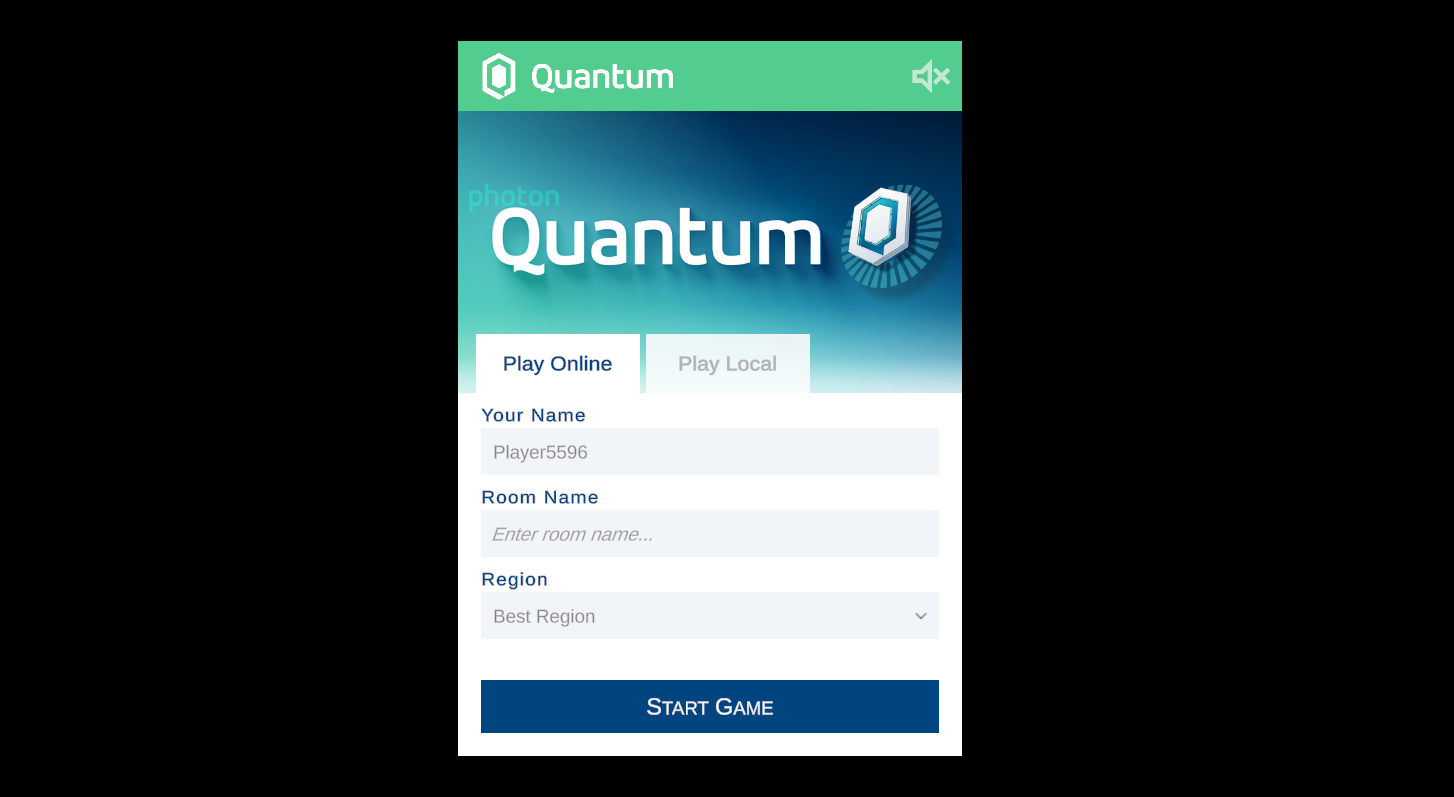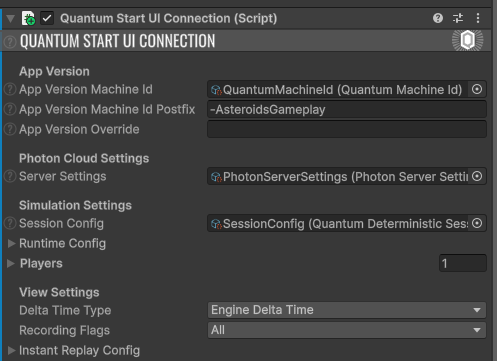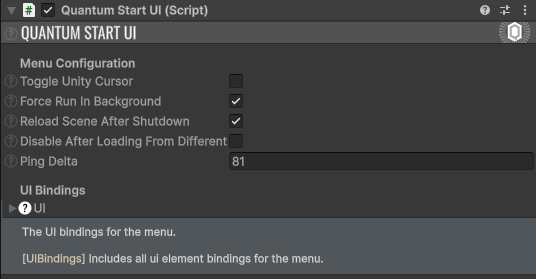Start UI
The Quantum StartUI consist of a Prefab and a few Unity scripts that make a Quantum scene run-able in local and online mode.
It can be used as a simple connection menu, it's easy to add small variations to and it should be used as reference to start a custom game menu in each developers own style.

Use the StartUI
- open a Unity scene that includes a Quantum
Map - run the Unity Editor menu command
Tools > Quantum > Setup > Add Start UI To Current Scene
A new GameObject is created with a pre-configured Unity Canvas. The QuantumStartUI prefab is instantiated as a child game object.
The prefab receives one variation which is saved on the scene: the QuantumStartUIConnection script. It contains the actual Photon cloud connection logic and can start the Quantum simulation using Quantum configs like PhotonServerSettings, RuntimeConfig and RuntimePlayer. When adding the UI via the Unity Editor menu script the current scene is tested for a QuantumRunnerLocalDebug script to pre-configure QuantumStartUIConnection members.

Hierarchy and Classes
The StartUI is built with two main classes:
QuantumStartUIcontrols the UIQuantumStartUIConnectionstarts and shuts down the connection and Quantum simulation
QuantumStartUI
This script contains the UI bindings and UI state machine. The bindings and control registrations are done verbosely in code and there are no hidden settings in the Unity inspector.
The class has a subclass UIBindings to make the inspector have a foldout. Elements are the actual UI controls and Toggles are mostly on/off switches. Some of the elements can be set to null to disable their feature which is mentioned in the fields code comment.

Possible UI states are Idle, Starting, Running and ShuttingDown. By default the complete scene is reloaded after shutting down, this can be disabled by toggling off ReloadSceneAfterShutdown.
It has a rudimentary tab system. Some tab names are unused like Settings and Custom. Getting the tabs and a few other toggles to work without additional wrappers uses a small trick to toggle two states:
C#
UI.InputTabs[(int)Tab.Online].transform.Find("On").gameObject.SetActive(tab == Tab.Online);
All of the members are protected and all of the methods are protected virtual to be easily extendable to include small variations quickly.
When specifying a room name a toggle called "private" appears. This toggle will set the room to IsVisible false preventing the random matchmaking to add players. Instead other player have to enter the same room name and region to join.
QuantumStartUIRegionDropdown
A wrapper around the Unity Dropdown script that downloads available Photon regions when being clicked.
The class has a partial implementation with the actual connection logic because of internal code organization.
QuantumStartUIConnection
The class performs the actual connection, session starting and shutdown logic. It implements the abstract class QuantumStartUIConnectionBase, and its main functionality is inside
Task ConnectAsync(StartParameter startParameter)andTask DisconnectAsync()which are both called by the UI classQuantumStartUI.
The menu uses Task and async keywords. Read more about them on this page Starting Session > Async Extensions. The methods are not strictly pure async because they are not enqueued and perform actions before synchronizing using the await keyword, but for simplicity this is omitted.
Online and local game modes are supported.
ConnectAsync() performs four steps:
- Connect to the Photon cloud and enter a Photon room:
MatchmakingExtensions.ConnectToRoomAsync()(online mode only) - Subscribe to server error channel:
QuantumCallback.SubscribeManual<CallbackPluginDisconnect>(online mode only) - Configure the game configs and start the Quantum simulation:
SessionRunner.StartAsync() - Add the players to the game:
Runner.Game.AddPlayer()
DisconnectAsync() is intended to be used at any time - when still connecting or when the online session has been started and the game is running.
It uses a CancellationTokenSource to signal the async methods MatchmakingExtensions.ConnectToRoomAsync() and SessionRunner.StartAsync() to cancel.
Afterwards the CallbackPluginDisconnect is disposed and runner and client are shutdown and disconnected.
Read more about connecting and starting the Quantum session:
To catch errors that occur between requesting the online Quantum simulation to start and finally starting locally and to let the UI know about them and also runtime errors that the Quantum server may invoke on the client the process subscribes to the CallbackPluginDisconnect callback before calling SessionRunner.StartAsync().
C#
_pluginDisconnectSubscription = QuantumCallback.SubscribeManual<CallbackPluginDisconnect>(m =>
startParameter.OnConnectionError(m.Reason)
);
Errors are reported back to the UI using the OnConnectionError action on the start parameter. The subscription is disposed when the game and connection are shut down.
App Version
The AppVersion used when connecting to the cloud controls which players can be matched against each other. Quantum is very sensitive to any asset or code differences between builds or Editors. By default the AppVersionMachineId is selected which generates a machine and checkout specific unique id. Only players using builds from this machine will be matched together.
Use the AppVersionMachineIdPostfix to additionally separate the players by the map name.
Use AppVersionOverride to set an explicit app version (requires AppVersionMachineId to be null).
QuantumStartUIMppmCommand
The Quantum MppmCommands are used to communicate between Editor instances using Unity 6 Multiplayer Play Mode. It will synchronize clicking start in one of the instances and makes sure that subsequent Editor instances automatically start and get into the same game.
The QuantumStartUIMppmConnectCommand is used inside the QuantumStartUI class. Invoked inside ConnectAsync() and handled by TryExecuteMppmCommand().
Features that are Not Implemented
- (Custom) authentication, usually requires an API call to a third-party authentication provider and then configuring
MatchmakingArguments.AuthValuesaccordingly. - Reconnection logic, usually requires a switch to call
MatchmakingExtensions.ReconnectToRoomAsync()instead and a proper usage ofQuantumReconnectInformation. - A main menu that can start different scenes.
- Instead create a simple main menu that loads individual scenes without connection logic, each with their own instance of
StartUI. - Or use the
QuantumMenuwhich provides a more complex implementation of a start menu.
- Instead create a simple main menu that loads individual scenes without connection logic, each with their own instance of